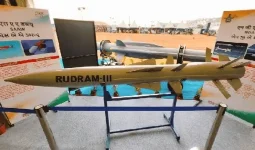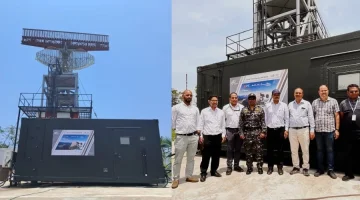- Views: 3K
- Replies: 10
Since the 2019 Balakot airstrike targeting a terrorist camp inside Pakistan, India has significantly enhanced its arsenal of long-range missiles. The introduction of sophisticated weapons like the Rudram-II, ROCKS, SCALP, and BrahMos-A missiles has notably improved the Indian Air Force's (IAF) capacity to execute precise strikes deep within Pakistani territory without its aircraft needing to cross the International Border (IB) or the Line of Control (LoC).
These advancements in military technology, spurred by insights gained from the Balakot operation and ongoing regional security concerns, boost India's ability to strike targets from a safe distance. This allows for targeted military operations while reducing potential risks to Indian aircraft and pilots.
Lessons from Balakot Drive Standoff Capability
The airstrike on February 26, 2019, was a significant event. Undertaken in retaliation for the Pulwama terrorist attack that claimed the lives of 40 Central Reserve Police Force personnel, IAF Mirage 2000 jets flew across the LoC to hit a Jaish-e-Mohammed facility located about 80 kilometres inside Pakistan's Khyber-Pakhtunkhwa province.While the mission achieved its objective, subsequent events, including the downing of an IAF MiG-21 and capture of its pilot by Pakistan, highlighted the dangers associated with entering heavily defended airspace. This experience emphasized the strategic need for weapons that could accurately strike distant targets without exposing IAF assets to Pakistan's air defence systems.
Consequently, since 2019, the IAF has focused on acquiring and integrating long-range missiles and guided bombs. This strategy allows strikes against targets such as terrorist infrastructure or key military installations within Pakistan to be launched from within or near Indian airspace.
Missiles like Rudram-II, ROCKS, SCALP, and BrahMos-A, all introduced or tested after 2019, are central to this enhanced capability, offering the range and accuracy needed for deep strikes without crossing borders.
Key Additions to India's Long-Range Arsenal
- Rudram-II: Advanced Indigenous Missile: Developed domestically by the Defence Research and Development Organisation (DRDO), the Rudram-II is a supersonic missile launched from the air, designed primarily to target enemy air defence systems (known as SEAD or Suppression of Enemy Air Defences) and ground targets. Following successful flight tests, including one on May 29, 2024, from a Sukhoi Su-30 MKI aircraft, this missile represents an advancement over the earlier Rudram-I. With a reported range nearing 300 km and carrying a 200 kg warhead, Rudram-II can neutralize radar stations and fortified positions from significant distances. Its sophisticated guidance system ensures accuracy, making it a valuable asset for disabling enemy air defences before other aircraft proceed with missions. It is initially integrated with the Su-30 MKI, with plans for deployment on Rafale and Tejas aircraft.
- ROCKS: Israeli Air-Launched Ballistic Missile: Acquired from Israel's Rafael Advanced Defense Systems after 2019, ROCKS is an air-launched ballistic missile (ALBM). Reports suggest it is intended for precise surgical strikes, potentially replacing older munitions for certain roles. ROCKS offers a range estimated around 250 km and carries a substantial 500 kg warhead, suitable for destroying well-protected targets like bunkers or command centres. Its high speed and flight path make it challenging for air defence systems to intercept. Deployed on Su-30 MKI and Rafale jets, ROCKS enables the IAF to strike targets deep within Pakistan, such as those near major cities like Rawalpindi or Lahore, while launching from safer positions within Indian airspace.
- SCALP (Storm Shadow): Long-Range Cruise Missile: This Anglo-French air-launched cruise missile arrived as part of the armament package for India's Rafale fighter jets, which began service in the IAF in July 2020. SCALP is designed for deep penetration strikes against high-value, heavily defended targets. Possessing a range reportedly exceeding 500 km and equipped with a powerful 450 kg warhead effective against hardened structures, its key advantage lies in its stealthy flight profile. SCALP flies at low altitudes, following the terrain to avoid radar detection. Integrated with the Rafale's systems, it provides a potent capability to strike strategic targets deep inside enemy territory, potentially launched from secure locations far from the border.
- BrahMos-A: Air-Launched Supersonic Cruise Missile: The BrahMos-A is the aircraft-launched version of the Indo-Russian BrahMos supersonic cruise missile. Successfully tested in May 2019 and officially inducted in 2020, the IAF has steadily integrated it onto its Su-30 MKI fleet. As of mid-2024, around 40 Su-30 MKIs were reportedly modified to carry the missile, with plans to equip more aircraft. An extended-range variant, tested in recent years, is believed to have a reach of 450 to 800 km. Travelling at speeds up to Mach 3.5 (three and a half times the speed of sound) and capable of extremely low-altitude flight, BrahMos-A is very difficult to intercept. It can accurately strike both land and sea targets, making it suitable for hitting time-critical objectives like active terrorist camps or military command posts deep within Pakistan, launched from airspace over regions like Rajasthan or Gujarat.
Strategic Implications
The acquisition and integration of Rudram-II, ROCKS, SCALP, and BrahMos-A since 2019 have significantly transformed the IAF's long-range strike options.These weapons, with ranges spanning 250 to 800 km, allow India to conduct precise strikes deep into Pakistan from the relative safety of its own airspace, thereby lowering the risks associated with border violations and potential escalation.
Coupled with advanced aircraft like the Su-30 MKI and Rafale, and supported by modern intelligence gathering platforms, these capabilities strengthen India's military deterrence and counter-terrorism posture.
As India continues to pursue next-generation technologies, including hypersonic systems, its capacity to project power without physically crossing borders is likely to further shape the region's security landscape.


